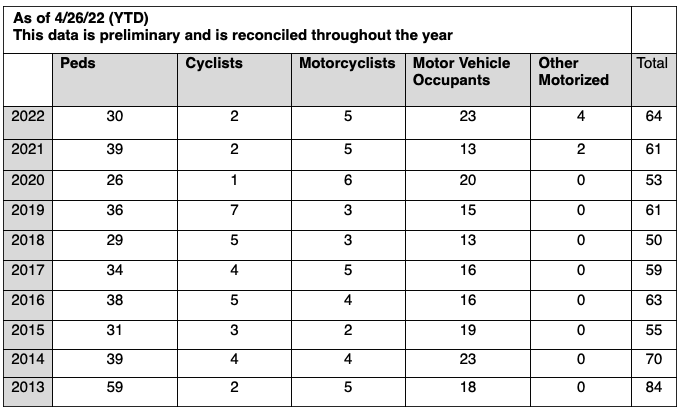Council Member Carlina Rivera reintroduced a pair of bills on Thursday that would establish offices for both a bike and a pedestrian "mayor" — and this time, the goal is to better carry out the Streets Master Plan.
"There is funding for the plan," the Manhattan Democrat said of Council-mandated benchmarks for bike lane, bus lane and pedestrian plaza construction, "but in order to implement it and to have have effective interagency communication, you do need a point person and an office to coordinate all of this."
Rivera said that she envisioned the new offices, first proposed in 2019 during an increase in cyclist and pedestrian deaths, as similar to the Mayor's Office of Criminal Justice, a City Hall unit that looks at the entirety of city's criminal justice infrastructure. In the absence of a citywide agency like the proposed Office of Public Space Management, the two possible City Hall-level officials could more directly address cyclists and pedestrians concerns beyond merely asking the Department of Transportation for better infrastructure.
Here’s @ydanis after a TV newser said there were “more important” things to spend money on than a bike mayor: "People who make such comments want to maintain the city of New York as a city where inequality is the definition of who we are.” @CarlinaRiverahttps://t.co/jNTx4vObdF pic.twitter.com/PG7pkmlMap
— Streetsblog New York (@StreetsblogNYC) November 26, 2019
"Until it happens, we're still going to have city government working at cross purposes and building an unsafe bike network," said Bike New York Director of Advocacy Jon Orcutt. "You can keep doing these things on the street, but if the cops don't respect it and Sanitation has no way to work through it, it just doesn't work without some central brain thinking about this stuff."
As laid out when the bills were first introduced, an active transportation mayor could be in charge of things like identifying particular hotspots with 311 complaints and making sure they don't get lost in the shuffle of other complaints or get quickly shunted aside by police officers who don't even respond.
A lot has changed since the bills establishing the offices were introduced in 2019, some for the better and some for the worse.
"Throughout the pandemic, active transportation has become more popular," Rivera told Streetblog. "We have more and more people relying on bikes and other forms of active transit for commuting.
"This is not a trend, it's not going away. These are New Yorkers from all walks of life, who are realizing that New York City should be a place where you can take your scooter or skateboard, you can rollerblade or bike to work safely," she added.
At the same time, the city is backsliding on its Vision Zero goals. In a year where 30 pedestrians and two cyclists have already been killed, and 3,400 more have been injured, there's a clear need for "someone with the political capital and authority to make streets safe in every borough if we're going to reverse this horrific trend of people dying on our streets," Rivera said.

The bills for a "bike mayor" and a "pedestrian mayor" are part of what Rivera calls a People-Powered Mobility agenda, which includes:
- A Greenways Master Plan bill would expand on the original city greenway plan, which hasn't been updated since it was introduced in 1993. The bill would require the departments of Transportation, Parks, City Planning, Design and Construction and Environmental Protection to, by July 1, 2023, create "a citywide greenway master plan that details the development and maintenance of greenways throughout the city."
"This bill isn't focused primarily on existing greenways or new greenways, but rather a comprehensive master plan, a vision for the future of greenways in New York City," Rivera said. "For far too long investment in green infrastructure has been reserved for only the wealthiest neighborhoods [or] is more of a collection of fragments than anything else." Or the segments are just horribly maintained, like Ocean Parkway
Most important, the greenways also aren't a unified collection of active spaces, with park connections or waterfront access full of holes in every borough where the city or state has attempted to build them out.
- A bill that would require the Department of Transportation to host a real-time map displaying the conditions of the city's bike lanes, including temporary detours for construction — just as Google maps, for example, seems to track every single fender bender to help drivers get around in real time.
How will Rivera's bills fare with the new mayor? Well, the last time she put forth her bike and pedestrian mayor bills, then-Mayor de Blasio dismissed them, sniffing that "New York City already has a [bike] mayor" — namely himself. This time around, City Hall seems more amenable.
BREAKING: Our ‘Bike Mayor’ story has just been updated with quote from @NYCMayorsOffice: ‘The mayor is already the Bike Mayor.’ (We’re pretty sure @NYCSpeakerCoJo, @TransAlt @BrooklynSpoke and @CarlinaRivera disagree!)https://t.co/IRxLwqLLfJ pic.twitter.com/SgzhVduQng
— Streetsblog New York (@StreetsblogNYC) May 29, 2019
“With an historic $900 million investment in street safety and a bold plan to redesign 1,000 intersection, Mayor Adams has led the fight to stem the tide of traffic violence in our city, and we look forward to working with Council Member Rivera and her colleagues on any legislation that will advance that work,” said a City Hall spokesperson.






